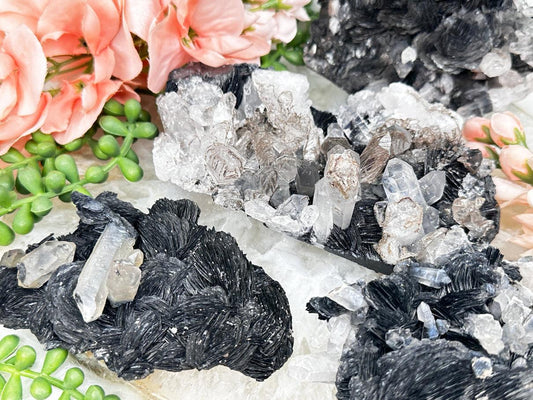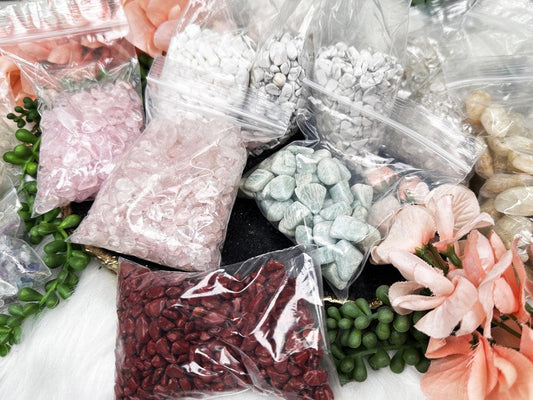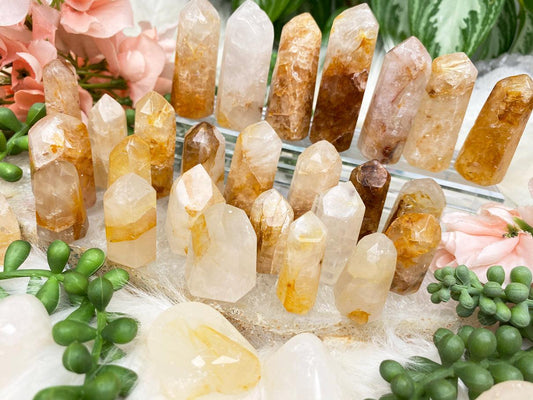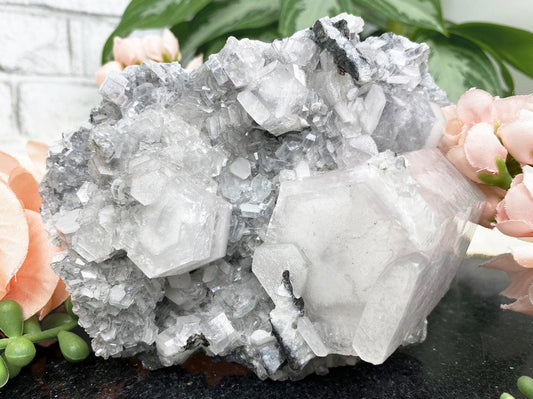Quartz crystals are one of the most abundant and can be found in nearly every color. These crystals are known for their soothing and cleansing energies. They can also be used for protection, motivation, chakra balancing, wisdom and awareness.
We offer multiple products that feature Quartz crystal and may be found forms like tumbled and worry stones, clusters, pendulums, points and other carvings. We also have beautiful jewelry and décor pieces that’ll bring healing in your life! Read more about the quartz crystal meaning at the bottom of the page!
-
Uruguayan Druzy Calcite
Regular price $48 - $145Regular priceUnit price per -
Moroccan Quartz Clusters
Regular price $5 - $18Regular priceUnit price per -
Hematite Rose & Quartz
Regular price $50 - $475Regular priceUnit price per -
Crystal Chip Bags
Regular price $7 - $26Regular priceUnit price per -
Enhydro Agate
Regular price $15 - $36Regular priceUnit price per -
Yellow Mica Quartz
Regular price $40 - $465Regular priceUnit price per -
Small Lemurian Quartz Points
Regular price $6 - $11Regular priceUnit price per -
Rutilated Quartz Pendant
Regular price $14.00Regular priceUnit price per -
Rutile Quartz Points & Lens
Regular price $14 - $33Regular priceUnit price per -
Brazil Quartz Points
Regular price $10 - $22Regular priceUnit price per -
Dolomite Quartz Cinnabar
Regular price $50.00Regular priceUnit price per$66.00Sale price $50.00 Sale -
Yellow Halloysite Quartz
Regular price $5 - $18Regular priceUnit price per -
Herkimer Diamonds
Regular price $40 - $70Regular priceUnit price per -
Quartz Dolomite & Chalcopyrite
Regular price $385.00Regular priceUnit price per -
Golden Healer Points & Pebbles
Regular price $3 - $5Regular priceUnit price per -
Cracked Quartz Points
Regular price $14 - $33Regular priceUnit price per -
Agate Stars & Moons
Regular price $18 - $23Regular priceUnit price per -
Madagascar Quartz Pebbles
Regular price $6 - $16Regular priceUnit price per -
Morocco Quartz Magnet
Regular price $10.00Regular priceUnit price per -
Walter Lopes Fantasy Quartz Points
Regular price $19 - $39Regular priceUnit price per -
Mixed Tourmaline in Quartz
Regular price $7 - $38Regular priceUnit price per -
UV Gray Chinese Calcite
Regular price $135 - $750Regular priceUnit price per -
Himalayan Quartz Clusters
Regular price $58 - $85Regular priceUnit price per -
Phantom Quartz Points
Regular price $8 - $45Regular priceUnit price per$10 - $60Sale price $8 - $45 Sale
Quartz is a group of minerals that can be found in igneous rocks such as granite and sedimentary rocks like sandstone and shale. They’re formed as a result of magma cooling down slowly which is vital for the crystallization. The main components in these crystals is silicon and oxygen which makes up the compound silicon dioxide. There are some other impurities in this gemstone such as lithium and titanium which result in specimens like Amethyst, Smoky Quartz, Citrine, Rose Quartz and much more. Numerous crystals like Agates and Jasper crystals also contain a network of Quartz.
Quartz is a silicon dioxide mineral. It’s particularly hard with a 7 on the Mohs scale. This crystal is also durable in high temperatures. The fracture is conchoidal when the mineral breaks.
Quartz’s name comes from the Polish word “kwardy” which means hard. This resembles the significant hardness of the stone.
What does Quartz look like?
Quartz, arguably the most well-known crystal, is a crystalline mineral that ranges from from a transparent clear coloring to a solid milky white. Quartz can looks and feel like glass because of its nearly see-through appearance and incredibly smooth, almost flawless sides. They can often have internal cracks that cause rainbows or many other types of inclusions of other minerals.
Quartz is the most common mineral in the continental crust and is present in almost every rock and all three types (sedimentary, igneous, and metamorphic).
This mineral is so common that beach sand comprises large amounts of quartz; the whiter the sand, the higher the quartz content.
Quartz has a notable hexagonal structure of six flat sides and comes to either one point or can be pointed at both ends (it looks similar to a pencil). Quartz is most commonly found in “wands,” clusters, geodes, and as particles within other rocks.
Because it is so common, it can often have a wide variety of looks especially due to inclusions of other minerals and can take on nearly every shade from grays, to pinks, to yellows, to black and everything in between.
Despite the fact that quartz is one of the most common minerals found, it has been knocked-off as both lab grown and glass imitations. If it looks TOO perfect, like perfect points, perfect cluster formation as a 360, etc., or if there are tiny little bubbles (not to be confused with natural enhydro bubbles), it is likely fake. But this is nothing new, the first ‘home grown’ quartz was in the 1840’s haha. Still be careful.
Learn more about the quartz family of crystals, including how to differentiate between the stones on the blog post dedicated to that.
Difference Between Clear Quartz & White Quartz
Clear Quartz and White Quartz, both belonging to the vast family of quartz crystals, share some similarities but also exhibit distinct differences. The most apparent distinction lies in their color and clarity.
Clear Quartz

Clear quartz is a remarkable variety of quartz known for its transparent appearance and crystal clarity. Clear quartz exhibits various shades, including colorless, white, or slightly tinted hues. Its prismatic structure, with six-sided terminations, contributes to its distinct appearance.
Clear quartz is renowned for its ability to amplify energy and intentions, making it a versatile healing crystal in spiritual practices, meditation, and energy work. Associated with all chakras, clear quartz is believed to enhance mental clarity, focus, and spiritual awareness.
Milky Quartz
Milky quartz is a variant of quartz that exhibits a milky or cloudy appearance due to microscopic inclusions. Unlike clear quartz, milky quartz appears opaque with a milky or cloudy undertone. This distinctive look arises from the presence of tiny inclusions, often composed of minerals like feldspar or water.
Milky quartz is a common variety found in various geological settings. Its cloudy appearance is a result of trapped gases and mineral impurities during crystal formation. While sharing general healing properties with clear quartz, milky quartz is often associated with emotional healing and calming energies.
In metaphysical practices, milky quartz is linked to spiritual significance, enhancing introspection and inner vision. Its soothing qualities make it suitable for meditation, contributing to emotional balance and stress alleviation. Understanding the features of clear and milky quartz allows individuals to choose the variety that aligns with their intentions in crystal work and metaphysical practices.
Where does quartz come from?

Quartz, a mineral with a global presence, is mined from various countries across the world. Brazil stands out as a significant producer of quartz, boasting an extensive range of varieties. The state of Minas Gerais in Brazil is renowned for its rich quartz deposits, including clear quartz, amethyst, citrine, and smoky quartz. France is another notable contributor, with regions like Auvergne yielding milky quartz and rock crystal.
Germany also plays a prominent role in quartz production, particularly in the Black Forest region, where high-quality smoky quartz and quartz crystals can be found. Madagascar, located off the southeastern coast of Africa, is home to significant quartz reserves, with notable varieties such as rose quartz. Additionally, China offers a diverse range of quartz types, showcasing a spectrum of colors and characteristics. These include beautiful specimens like citrine, smoky quartz, and amethyst. Other countries such as Japan and South Africa also contribute to the global quartz supply, each with its unique selection of quartz varieties.
Quartz Crystal Meaning
This crystal is known as the “master healer” because of its power to amplify the properties of other crystals. Quartz is said to enhance mindfulness, minimize negative energy, clear the mind and spirit of any “clutter,” and help bring you to your higher self through its high vibrations. Because of its cleansing abilities, quartz is often used in feng shui by being placed in an area that needs energy purification. Quartz removes negative energy by absorbing it, and it is suggested that you clean your crystals regularly to cleanse them of that absorbed energy. It can actually cleanse other crystals. A Quartz charging plate or bowl to place your other crystals can be a great way to energize your whole collection!
Beyond its regular crystal healing properties, quartz is also said to be one of the crystals that can be programmed to any intention or meaning. This is why it is a great beginner crystal because it is so versatile.
Quartz crystals are well known for helping with healing because they amplify soothing energies. They also have an ability to absorb the negativity, balance your soul out and clear your mind. If you’re in need of a reset and deep cleansing then feel free to try this gemstone out! It can even increase emotional resilience, awareness and cognitive abilities. This crystal will motivate you to take the right actions to upgrade your career and relationships. Quartz also works to cleanse and align all your chakras. More specifically, certain varieties are connected to different chakras such as Clear Quartz activating the Crown Chakra and Amethyst meaning working with the Third Eye one.
What is quartz used for?

Quartz is a great jewelry option because it looks magnificent and brings healing and balance at the same time. You can even carry it with you in other forms like tumbled stones. Another great way to use this crystal is by introducing it to your meditation, prayer and crystal gridding practices. This stone can also be combined with other crystals to amplify their effects. There’s also an endless amounts of Feng Shui placements you can try out in your home like near the bed for better rest. With all this being said, Quartz crystals are a necessity for your crystal collection and alter. They are also a wonderful gift for the crystal enthusiasts in your life!
If you want to learn more about how to tell the difference between quartz and the other members of its family, check out this blog post!

More About Quartz
Quartz has been around for forever it seems. It was widely known by ancient Greeks who called them krystallos, which is how they got the name crystals. The world quartz comes from the German word ‘quarz’. It has a long history as being used in electronics, and still is to this day which is pretty cool to think about!
This crystal is a 7 on the Mohs hardness scale, making it stronger than most minerals and can even scratch steel. Because of its strength, quartz rarely breaks, but if it does, it is more likely to chip in conchoidal fractures (circular patterned breaks that resemble a seashell).
Quartz Localities: Worldwide... like literally almost anywhere crystals can be found haha.
Chakra: Crown
Quartz Inclusions
Quartz, a versatile and abundant crystal, often grows in harmony with other minerals, resulting in a stunning variety of inclusions. These inclusions, while adding to the crystal's visual appeal, also contribute to its metaphysical properties and uniqueness.

One of the most common inclusions in quartz is rutile. Rutile appears as delicate, golden, or reddish-brown needles or threads within the quartz matrix. These needle-like inclusions create intricate and captivating patterns that are highly sought after by crystal enthusiasts. Rutile-infused quartz is believed to amplify the crystal's energy, making it a potent tool for enhancing one's spiritual journey and personal growth.
Chlorite is another inclusion often found in quartz crystals. It manifests as green, platy or fibrous inclusions that create a lush, mossy appearance within the crystal. Chlorite-infused quartz is associated with healing, detoxification, and cleansing energies. It is believed to facilitate emotional and physical well-being, making it a popular choice for those seeking holistic healing.
Lepidocrocite is a red or crimson mineral inclusion that can give quartz crystals a fiery and passionate appearance. This inclusion is associated with emotional healing, love, and enhancing one's intuition. Lepidocrocite-infused quartz is cherished for its ability to promote self-love and ignite the flames of passion in one's life.

In addition to those, quartz can host an extensive range of other inclusions, including but not limited to goethite, brookite, hematite, tourmaline, chlorite, feldspar, and pyrite. These inclusions contribute to the quartz's overall energy and appearance, making each specimen a unique and valuable addition to the world of crystal healing and metaphysical exploration.
In addition to these inclusions, quartz is known for its remarkable ability to grow alongside and even into other crystals. This growth phenomenon results in captivating formations like quartz with amethyst, citrine, or smoky quartz. These combinations blend the properties of both crystals, creating powerful and harmonious energies.
Quartz's affinity for coexisting with various minerals leads to a rich tapestry of inclusions and formations, each with its own unique beauty and metaphysical significance. Exploring the world of quartz reveals a captivating journey through the wonders of the Earth's crystalline treasures.






























